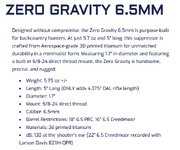Where is the information listed about the testing protocol with these side-by-side tests?
There is no "standard barrel length for 6.5 CM" or any other caliber - at least not explicitly in any kind of nonexistent industry regulations - but there are commonly accepted standards in the industry as used at the TBAC Summit and by Pew Science.
Part of the issue with shopping for a suppressor is the lack of well-defined industry standards and the difficulty of conducting sound tests - as Unknown Suppressors has repeatedly explained - but there are clear military standards and testing setups out there which manufacturers could choose to follow. Results can vary day-to-day based on environmental conditions. So the instant someone starts to take measures that look to me like they are trying to get away from the most common test setups - using a common .308 round (e.g. M118LR) in a 20" barrel - I get really suspicious. Maybe it doesn't actually amount to a measurable difference, but it bothers me that they chose to use a longer barrel and an unspecified round. I am going to assume that many manufacturers will try to put forward the best possible verifiable data, but I least want the starting point for the test to be as close as possible so I have some idea how something really compares.
The other measurables look really attractive.



